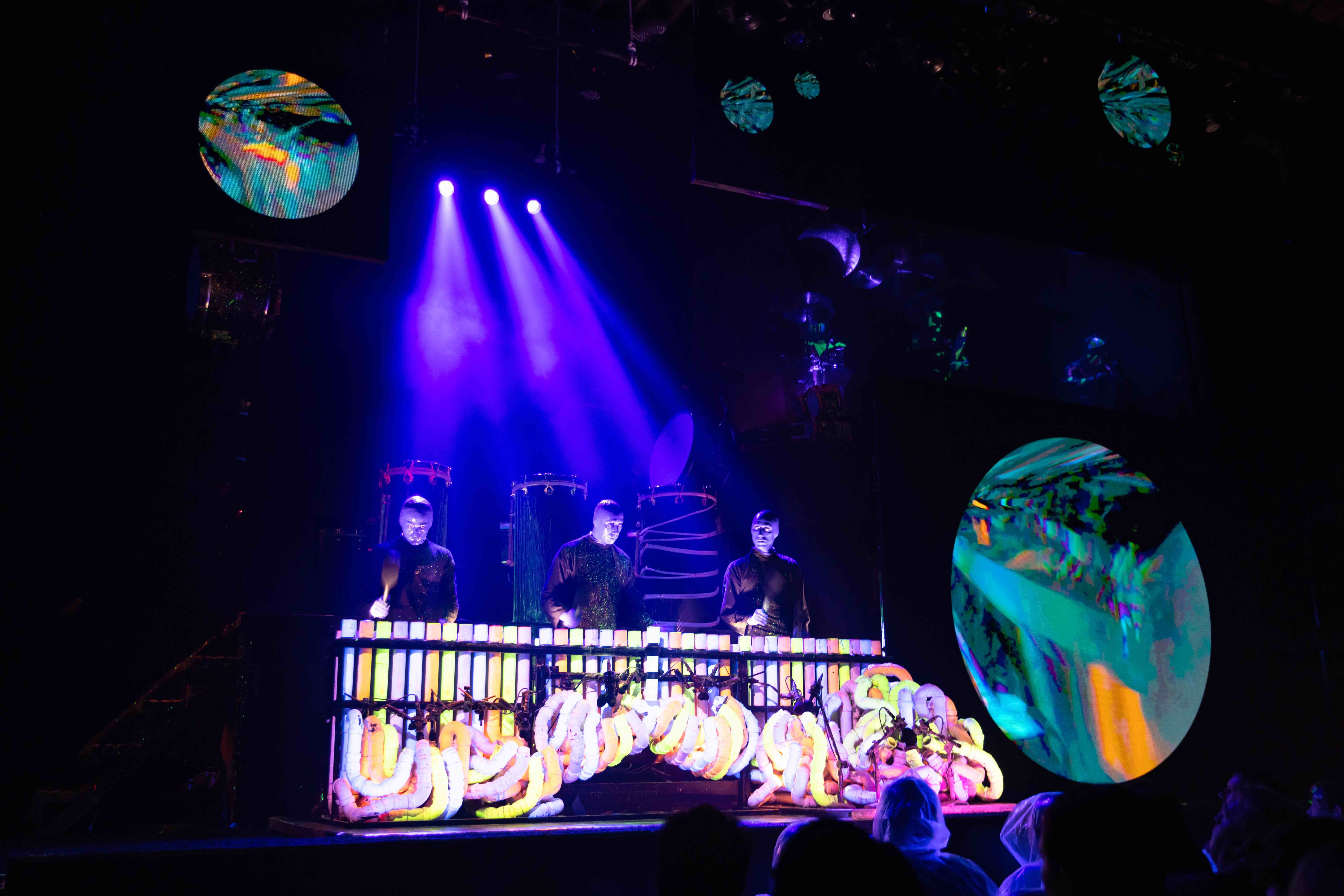
Blue Man Group started as outsider art, railing against the machine of corporate commodification and end-stage capitalism. Now it’s become a perfect performance entrée for kids and their families, which is fine (especially during matinees).
Biking through traffic past Chicago’s ubiquitous glut of August street fairs, from Retro on Roscoe (stopping to fist pump with the seasoned female rockers in The Prissillas) to Northalsted Market Days (always a rocking queer street party), we arrive at Briar Street Theatre. The venue was built in 1901 as a stable, and has spent the last 25 years hosting cobalt-colored horseplay.

Blue Man Group Chicago debuted new visual media in July, including 17 new screens scattered above the action across the apron with trippy new video content (attention gummy-eaters), alongside the old-school red CG crawl screens. Additional tech since the last time I saw BMG also includes security wanding at the door, a sign of our dangerous times.
The lobby’s quirky, interactive “tube talking” is gone, replaced with more fancy merch displays (including the paintball spit spin art created in each show), an exit through the gift shop as outsider artist Banksy imagined. A print of Andy Warhol’s tomato soup can near the coat check completes the nod to pop culture commentary. Newer elements also appear at the production’s highly interactive closing, with crepe paper canons and industrial-sized smoke ring-blowers to usher out the audience (and to provide endless cleanup for house management).

For a quarter century, the trio of unnamed azure actors ponders “what is art?" Is it in the presentation, or applied color, or carefully curated bodily secretions? And/or is it interactions with others? This current iteration, under the continuing “skeleton crew” of three musicians (including a Chapman Stick player), still has a splash zone in the first few rows of seats, to weather water, mediate marshmallows or capture Captain Crunch crumbs. Willing audience members are solicited to become outlines for paintball paintings, esophageal camera wranglers, and old-school daters (complete with a game of Twister, perhaps a bit too 20th century heteronormative?).
Twisters in the audience are spotlighted when rock moves are dissected, an oldie but a goodie. Rick Wakeman’s rock capes make an appearance too. The cell phone multiverse and airplane landing flashlight signalers comment on tech-boosted communications, and newer fishing pole light saber thingys offer a new whip it (whip it good) sound. Late arrivals continue to be spotlighted too, something that should probably happen in all theaters (as shame seems to be the only way to change behavior).

Lock Martin (Gort) and Michael Rennie (Klaatu) in The Day the Earth Stood Still (1951)
The Blue Men are both deadpan and hyper sensory, all eyes and mouths and hands, although they lack ears as well as full facial expressions. This viewing hearkened back to images of Lock Martin as Gort and Michael Rennie as Klaatu in the 1951 scifi film classic The Day the Earth Stood Still, featuring composed monoliths that are alternately engaging, mysterious and threatening.
They seemingly can’t hear, but they can jam, hard (they jam econo, as the Minutemen might say), with a vibe similar to kids drumming plastic cans on urban street corners. These Blues Brothers created a “found object” PVC symphony, still memorable in its repurposing of plastic piping as a modern-day organ (which evokes human intestinal organs) as well as a futuristic manifestation of a marimba. Their signature “Drumbone” remains primal and playful, evoking the childhood joy of collaborative improvisation, banging on found objects as the bass beat bounces our innards.
Seeing the Blue Men every few years—a must-see Chicago ambassador alongside the Bean, The Infinite Wrench and the various architectural boat tours—is an ever-changing reflection on the state of art, and the humans who create it, codify it, monetize it. The current moment is pondering the place of artificial intelligence in modern civilization (union actors and writers are a hard pass). These Blues Clues remain computer-esque, expressionless, like koken for artistic mischief. Does breaking norms beget lasting innovation? Are Blue Men the love children of humanity and technology?
And where are the Blue Women?

(After), "Nu Bleu I" by Henri Matisse (1869-1954).
Blue Man Group enters its 26th year at Briar Street Theatre, 3133 N. Halsted St. Tickets are $49-69. Goldstar often offers discounted tickets too. Parking is tough in Lakeview, so walking, biking or public transport is recommended.
For more information on this and other plays, see theatreinchicago.com.
Did you enjoy this post and our coverage of Chicago’s arts scene and sometimes beyond? Please consider supporting Third Coast Review’s arts and culture coverage by making a donation by PayPal. Choose the amount that works best for you, and know how much we appreciate your support!
